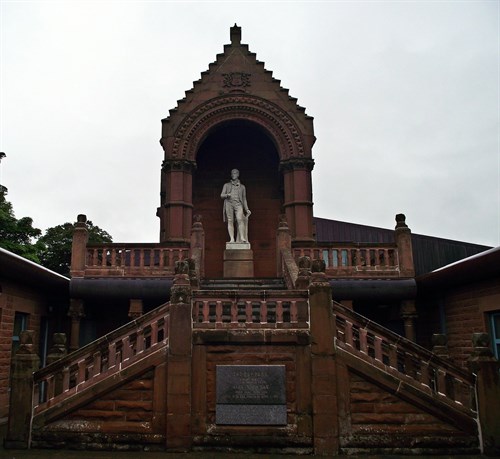Robert Burns Birthplace Museum
One of Scotland’s greatest exports (besides whisky, of course) is the poetry and legacy of Robert ‘Rabbie’ Burns. A forerunner of the Romantic poetry movement who inspired writers such as Samuel Taylor Coleridge and Percy Bysshe Shelley, Burns wrote poems in Scots language and English with Scots dialect, engaging with themes of inequality, republicanism and Scottish culture. Many of his poems have been put to folk music over the years since his death in 1796, and he is well-known today for ‘Auld Lang Syne’, popularly sung to ring in the New Year.
The Robert Burns Birthplace Museum, known as the Burns Cottage or the ‘auld cley biggin’ can be found in Alloway, Ayrshire on Scotland’s West Coast. The full museum experience is spread across six sites, including the three bedroomed, thatched cottage Burns was born in. The walls of the cottage have been daubed with snippets of Burns’ writings, immersing you in his world. The Museum building, which is connected to the cottage via the Poet’s Path, contains several exhibits that you can work your way through with an audio tour, viewing items that belonged to the man himself as well as several Burns manuscripts. Whilst you’re visiting the Museum and absorbing the world of Rabbie Burns, you should make sure to take a walk over Brig O’ Doon, the fifteenth-century bridge that features in Burns’ narrative poem, ‘Tam O’Shanter’.

Culzean Castle
A spectacular cliff-side sprawl, Culzean Castle set high on the coast of Culzean Country Park, is truly a sight to behold. Designed in the eighteenth century by Robert Adam, Culzean Castle is made up of 40 buildings. One of the most stunning features within the Castle is the Oval Staircase, a dramatic piece of architectural flair that sweeps through the centre of the Castle, decorated in original oil paintings and supported by tens of colonnades. The entrance hall is home to one of the largest collections of British flintlock pistols in the world, and there are plenty more treasures to be found on your visit. Out in the gardens, the Swan Pond, Ice House and fruit-filled greenhouses are waiting to be discovered – David Kennedy, 10th Earl of Cassillis and commissioner of the Castle, certainly wanted to impress visitors with his opulent visions.
The Castle is set in a 120 hectare country park, featuring a Deer Park which is home to red deer and llamas. There are over 17 miles of path you can choose to walk, winding through woodland, glades and glens. Between the Castle and Grounds, you’ll keep yourself busy and engaging with Scottish history for many hours.
Dick Institute
A great chronicler of local history, the Dick Institute in Kilmarnock plays a vital role in telling the stories both of Scotland’s past and present. The South Museum and Loom Room demonstrate what life was like for Scots in the south-west of the country centuries ago, a great spot to visit for anyone interested in social history. The North Museum, on the other hand, focuses on natural history sciences and archaeology – scene stealers here include a 400 million year old scorpion fossil and a dinosaur fondly known as Samantha.
Outside of these permanent exhibitions, the Dick Institute features a rolling calendar of other exhibits and events. These range from displays of contemporary Scottish artwork from artists such as Kenny Hunter and Christine Borland, to exhibits about illustrator Quentin Blake, and the Wallace and Gromit films.
Turnberry Lighthouse
If you’ve chosen to play the iconic Ailsa Course in Turnberry, then you can’t miss the Turnberry Lighthouse. Rising to 24 metres, the Turnberry Lighthouse has guided ships along the West Coast of Scotland since 1873, though the history of its surrounds reach back further into the annals of Scotland. It is said that the foundations of Turnberry Lighthouse have been laid on the moat of what was once Turnberry Castle, widely thought to be the birthplace of Robert the Bruce, King of Scotland and famous antagoniser of English rule.
The Turnberry Lighthouse has recently been converted to two luxury suites, ready for golfers to rest their clubs in. Each suite has its own balcony, offering magnificent views over the Irish Sea to the Isle of Arran. The windswept walk out to the Lighthouse is popular with locals and tourists, who are rewarded with stunning views from the café at the base of the building.